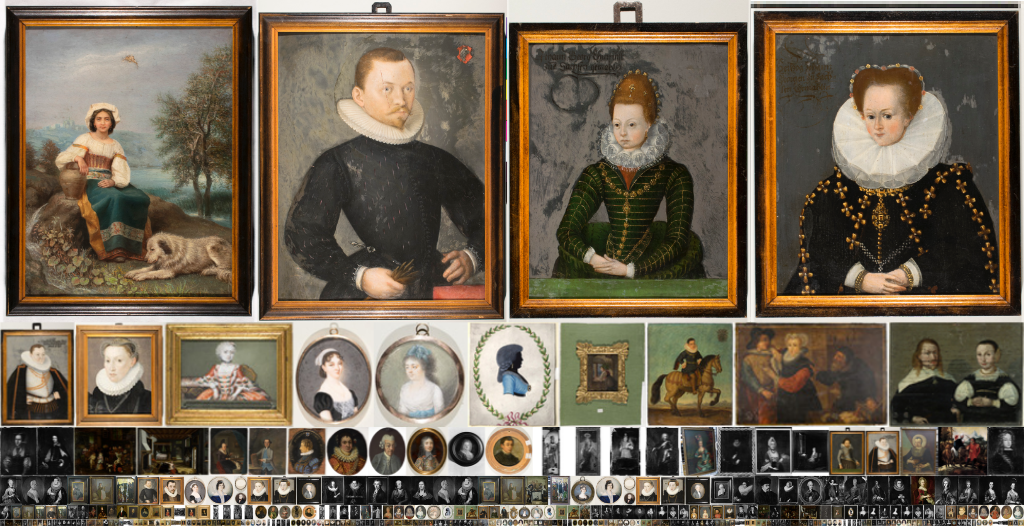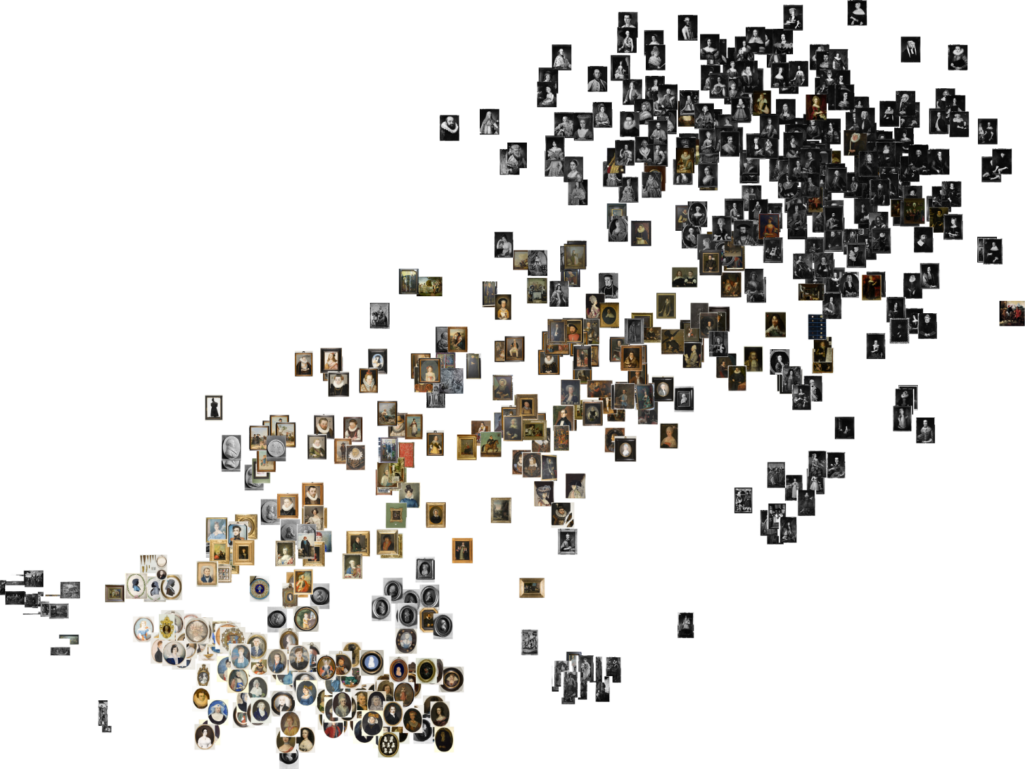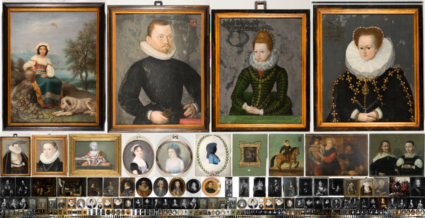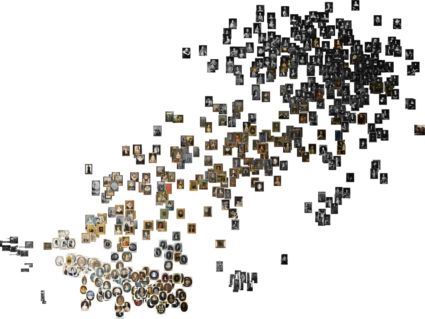The interdisciplinary research and digitalisation project "Restaging Fashion. Visualisation of Vestimentary Sources" (ReFa) has developed explorative approaches to holdings from the Berlin Art Library with its collection Modebild – Lipperheide Costume Library and from the Fabrics collection of the Germanisches Nationalmuseum Nuremberg.
Based on images of Lipperheidesche Kostümbibliothek, Kunstbibliothek, Staatliche Museen zu Berlin (CC-BY-NC-SA)
The Restaging Fashion project (11.2020 – 11.2023), funded by the Federal Ministry of Education and Research (BMBF) and based at the UCLAB at University of Applied Sciences Potsdam, is dedicated to the cultural history of clothing, its appearance and symbolism. The visualisation of the collection’s holdings brings together vestimentary sources in the digital realm and enables cross-source and multidisciplinary research on the objects. The starting point is the painting collection of 600 works donated by the Berlin publishing couple Franz and Frieda von Lipperheide in 1899. It documents fashion, costume and dress from the late Middle Ages to the 19th century. The paintings are complemented by 1,000 prints and hand drawings from Lipperheide’s costume library as well as text sources, such as archival documents on the history of the collection. However, the often fragile historical textiles provide decisive information; they expand the pictorial and textual information with the objecthood and materiality itself. Using 3D scanning and photogrammetry, the detailed, three-dimensional reproduction of 15 historical clothing ensembles and accessories from the Germanisches Nationalmuseum was trialled.
The UCLAB (Urban Complexity Lab) of the University of Applied Sciences Potsdam, project initiator with many years of experience in the visualisation of cultural data, tested experimental methods of collection presentation by means of visualisations, which are used on the one hand as an aid to content exploration and on the other hand as a tool for interpretation. In the Restaging Fashion project, image and metadata were visualised and made available in an iterative and collaborative design process. The chosen form of collection presentation allows contextualisation, an introduction through narrative elements and free exploration of the holdings. The result is a freely reusable prototype, the ReFa-Reader.
RESTAGING FASHION was a three year research project funded by the Federal Ministry of Education and Research (Bundesministerium für Bildung und Forschung) and a cooperation with Staatliche Museen zu Berlin and Germanisches Nationalmuseum Nürnberg.
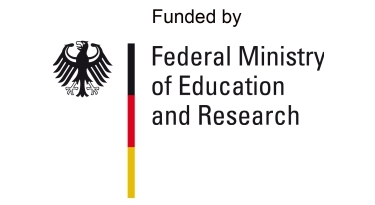
Publications
Associated Publications
—
in: Konferenzband zur 27. Berliner Veranstaltung der internationalen EVA-Serie: Electronic Media and Visual Arts,
2023
Cultural collections have transcended the boundaries of physical showcases and storage cabinets, evolving into intricate digital webs of interconnected data. The research project Restaging Fashion aimed to expand the possibilities for experiencing the linkages in digitized cultural heritage, focusing on the visualization of collection holdings related to the history of garments. Through graph-based narratives, the project investigated the complex interplay between the linear – and at times tentative – art historical discourses and the non-linear explorations of associated cultural heritage data. The resulting visualizations have been designed with the aim to allow for curated and dynamic exploration of the collection along research essays and their interrelated graphs.
—
ADHO Digital Humanities Conference 2023 (DH2023),
2023
This contribution explores the instructive tensions between art-historical research and semantic data modeling. While the potential of LOD-applications is obvious in terms of standardization and precision some aspects of research may not be formally represented. Therefore we propose to bridge LOD and full text descriptions through information visualization.
Expand
—
in: Konferenzband zur DHd2022: Kulturen des digitalen Gedächtnisses,
2022
Kleidung, Tracht und Mode kommunizieren die Vorstellung des Trägers von Schönheit, Status, Körper, Form, sozialer Hierarchie und religiöser Zugehörigkeit, kurz: die Identität des Trägers. Die Informationen in den historischen Quellen zur Kleidung, in bildlichen Darstellungen, beschreibenden Texten und textilen Artefakten, werden in dem interdisziplinären Forschungs- und Digitalisierungsprojekt „Restaging Fashion. Digitale Kontextualisierung vestimentärer Quellen“ (UCLAB, Fachhochschule Potsdam) interpretiert und kontextualisiert. Eine tiefe inhaltlche Erschließung, sowie im Projekt angefertigte Digitalisate bilden dafür die Datenbasis. Ein besonderer Schwerpunkt wird zum einen auf der prototypischen 3D-Digitalisierung historischer Kleidung liegen. Zum Anderen wird die Datenvisualisierung als epistemisches Werkzeug sowohl im Prozess der Erfassung genutzt als auch für die Sammlungspräsentation im Web eingesetzt.
Expand
—
Berliner Handreichungen zur Bibliotheks- und Informationswissenschaft; Band 484, Dissertation,
2021
Die vorliegende Dissertation „Ikonizität der Information“ befasst sich mit der ikonischen Dimension von Wissensorganisationssystemen (WOS) und dem epistemischen Potenzial von Bildlichkeit im Bereich des digitalen Kulturerbes. Dabei bezieht sich die Ikonizität der Information einmal auf eine implizite Dimension auf einer strukturellen Ebene sowie auf explizite Ausdrucksformen wie Visualisierungen, die Objekte und ihre Relationen topologisch darstellen. In einem interdisziplinären Ansatz, der sich unter anderem auf Bild-, Zeichen- und Medientheorie bezieht, werden sowohl aktuelle Visualisierungen als auch historische Entwicklungen in der Theorie und Modellierung von Wissensorganisationssystemen analysiert. Der Theorieteil, in dem die Konzepte Information, Zeichen und Ikonizität adressiert werden, stützt sich vor allem auf die universelle Zeichentheorie und das Konzept des diagrammatic reasoning von Charles Sanders Peirce und bildet die Basis für die Analyse. Die Vagheit und Mehrdeutigkeit oder simultane Pluralität visueller Ausdrucksformen bildet einen ikonischen Überschuss, welcher als maßgeblich für die Erkenntnisfunktion der Bildlichkeit identifiziert wird. Diese Forschung bietet einen theoretischen Rahmen für das Verständnis und die Konzeption von Visualisierungen und multimodalen WOS.
Expand
The collection of the Berlin publishers Franz and Frieda von Lipperheide, comprising more than 600 paintings, miniatures and reliefs, is part of an extensive and unique compendium of sources depicting the various forms of fashion, traditional costume and dress, referencing their specifics to social class, region and gender. As visual evidence of European and non-European dress fashions from around 1430 to 1900, the pieces in the collection alternate between artistic designs and documentary evidence. They were first made accessible to the public in 1906 as part of the Lipperheide Costume Library, donated to the Berlin Museum of Decorative Arts by Franz and Frieda von Lipperheide. Since 1934, however, they have been without a residence, and were later divided up and deposited. The present study is the first complete analysis of the collection, looking at its origin and history, its context as a repository of knowledge for the spouses’ publishing activities, its original scope, its strategy and the conception of sources. Furthermore, it highlights the original scope of the private collection, which comprised textiles, pictorial evidence, text sources and secondary literature. In the context of the 19th century, informed by museum foundations and a rebirth of the arts and crafts, the Lipperheide collection of paintings represents a methodological approach of an early costume historiography.
Expand
—
in: Konferenzband zur DHd 2020 Paderborn - Spielräume: Digital Humanities zwischen Modellierung und Interpretation,
2020
Das hohe Aufkommen und die vermehrte Relevanz digitaler Information haben den Bereich der Erschließung, Organisation und Vermittlung von Wissen nachhaltig verändert. Vilém Flusser wies bereits 1978 auf das „Ansteigen der Wichtigkeit von zweidimensionalen Codes“ (Flusser 1998: 22) in unserer Kultur hin, womit er die Kommunikation mittels Oberflächen im Gegensatz zu den linearen Medien der „eindimensionalen Codes“, wie das Alphabet meinte. Diese Oberflächen sind graphisch konstituiert und auch das Web selbst ist ein visuelles Medium auf struktureller Ebene. In diesem Sinne konstatiert auch Horst Bredekamp: „Die hochtechnisierter Gesellschaften durchleben eine Phase der kopernikanischen Wende von der Dominanz der Sprache zur Hegemonie des Bildes.“ (Bredekamp 2000: 102). Die Beschreibung und Analyse des Phänomens Bildlichkeit erfordert eine Bildtheorie, die sowohl in der Lage ist, traditionelle Bildformen als auch digitale Bilder zu adressieren und alle gesellschaftlichen Anwendungsbereiche, von künstlerischen über alltäglichen hin zu wissenschaftlichen Ausdrucksformen einzuschließen oder wie John Michael Krois es formuliert: „Eine Bildtheorie können wir dadurch testen, dass wir nachschauen, ob sie die sonderbarsten Eigenschaften von Bildern verständlich machen kann.“ (Krois 2011: 140)
—
Hrsg. netzwerk mode textil, in: Jahrbuch nmt 2020, S. 7-17,
2021
Ausgehend von den beiden Illustrationen zur Bekleidung eines Oberösterreichischen Bauern und einer Bauersfrau aus der Bauernkriegszeit, deren materielle und visuelle Quellen des Grafikers Alois Greil hier rekonstruiert werden konnten, entwickelte sich ein Bildbeleg für die Beständigkeit einmal formulierter Bildideen ländlicher Trachten. Aufbauend darauf unterstützte diese Visualisierung von Wissenssystemen die ganz dem Geist der rezipierenden und erneuernden Praxis der Tracht verpflichtete Tätigkeit des Volkskundlers Franz C. Lipp und bildete die Basis eines vestimentären Weiterlebens in rekonstruierten Museumsfigurinen, Kostümen und Vereinskleidungen. Die ausgewählten Bilder verdeutlichen den kommunikativen Prozess, durch den sich Erinnerungskultur, Identität und Tradition formiert. Methodisch ergab sich eine Kombination aus bildanalytischen und empirischen Verfahren von kunsthistorischem und volkskundlichem Blickwinkel, wobei die Praxis Franz von Lipperheides und August von Heydens, stellvertretend für die Kostümforschung des 19. Jahrhunderts, und ihr Nachwirken herausgearbeitet werden konnte. Als Forschungsergebnis ergab sich der Fakt, dass hier wesentlich mehr zeittypische Wertschöpfung mitwirkt als postuliert wurde.
Expand


